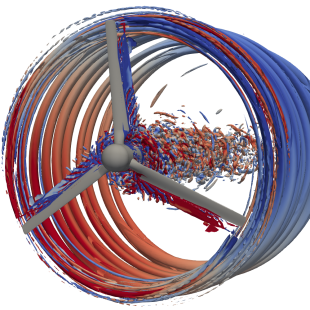The project "Morphing Blades: New-Concept Tidal (and Wind) Turbine Blades for Unsteady Load Mitigation" aims to demonstrate, at model-scale, a novel technology to reduce unsteady-loading for tidal and wind turbines, improving resilience and reliability and decreasing the levelised cost of energy. Within this project we have first demonstrated a new morphing technology based on a passively pitching rigid blade for tidal turbines. We now focus on providing further evidence on the effectiveness of this morphing technology, as well as demonstrating a new morphing concept based on fixed pitch blade with a flexible trailing edge. Furthermore, we aim to demonstrate these two concepts for both wind and tidal energy.
Tidal energy is a promising renewable energy source that can contribute to providing energy security for the UK. The world’s first arrays of tidal turbines have recently been deployed in Scotland, confirming the UK as a world leader in this emerging energy sector. One of the main technical challenges of harvesting energy from tidal currents is the large load fluctuations experienced by the blades. These can result in fatigue failures of the blades and in power fluctuations at the generator, and thus in a lower mean power when load peaks correspond to rated power. The aim of this project is to develop a technology that cancels the unsteady loading at its source, while adding minimal complexity to the turbine, to ensure high resilience and reliability of the overall system. Furthermore, morphing blades might entirely replace active pitch, ensuring high fluid mechanics efficiency while substantially decreasing the system complexity and the costs.
In our paper, Viola et al. (2022), we conceptualised the use of a passive pitch system on a turbine to maintain either constant thrust or torque. We described the first theoretical model of a morphing blade in Pisetta et al. (2022). Here, we showed that the thrust fluctuations can be mitigated by passively and elastically adjusting the pitch, resulting in no change to the mean torque and, thus, to the harvested power. We investigated this model with computational fluid dynamics (Dai et al. 2022), where we modelled a turbine with blades that were each attached to the hub by a torsional spring, allowing each blade to pitch passively about its axis. The rotor operated through a shear layer and the passive pitch blade showed a lower amplitude thrust and torque fluctuation than a fixed pitch blade. We then performed experiments on a 1.2-m-diameter turbine (Gambuzza et al. 2023) in the University of Edinburgh FloWave Ocean Energy Research Facility, a 30-m-diameter 2-m-deep recirculating open channel. The blades were connected to the hub through a torsional spring. The torque and thrust fluctuations due to turbulence and shear were significantly mitigated by the passive pitch.
The above-mentioned studies focused on mitigating fluctuations due to shear and turbulence over a period of the order of seconds. The spring stiffness and preload were chosen to match the hydrodynamic time-averaged pitching moment, such that the time-averaged pitch angle was the same as the pitch angle of an equivalent fixed-pitch blade. Therefore, the passive pitch system investigated in these earlier studies will used, for example, together with an active system that varies the pitch over the tidal period.
We are currently studying the ability of the passive pitch system to mitigate fluctuations with a period of the order of hours such as due to changes in the mean flow speed over the tidal period. We also aim to complement previous studies on the mitigation of high-frequency fluctuations by considering load variations due to yaw misalignment with the free stream. To this end, we recently tested a new passive pitch system on a 1.2-m-diameter turbine in the recirculating open water channel at the Institute for Marine Engineering of the Italian National Research Council (CNR-INM), in Rome, Italy - a low turbulence facility with a uniform onset flow without shear.
Furthermore, we are developing flexible blades such that the trailing edge deforms in response to a change in the aero/hydrodynamic load. The trailing edge deformation results in a change in the camber and angle of attack that allows a constant load even in variable flow conditions. We aim to demonstrate this novel technology through numerical simulations and experiments in FloWave and at CNR-INM.
Finally, we developed bespoke design tools based on blade element momentum theory for the design of either rigid blades that can passively pitch, or fixed pitch blades with a flexible trailing edge. We aim to exploit these design tools to demonstrate the suitability of our morphing blade designs for both the wind and tidal energy sectors.
The project, which is funded by the EPSRC (EP/V009443/1), is led by Prof. Ignazio Maria Viola, Dr Eddie McCarthy, Dr Anna Young (University of Bath), and Dr Riccardo Broglia (CNR-INM); as well as VOILAb members Dr Yabin Liu, Dr Puja Sunil, Dr Junchen Tan, and Kuba Frankowski; and world-leading tidal and wind energy technology companies such as SIMEC Atlantis Energy, Orbital Marine Power, Nova Innovation, Schottel Hydro, ACT Blades and the Wood Group.



